

Thinking vs. Feeling. Thinking and Feeling, exploring the differences The other kind of mental process identified by Jung is judgment, a process of organising and evaluating information, and coming to conclusions.

Using the judging process, some sort of evaluation is made and Jung identified two kinds of judgment: Thinking and Feeling. The T-F dichotomy is our ‘output’ scale - ie how we each make decisions. Both of these can be used in either the outer, extraverted world or in the inner, introverted world. Thinking judgments are based on objective criteria or principles, as Jung describes: ...judgement is reserved as to what significance should be attached to the facts in question. Feeling judgments are based on personal, interpersonal, or emotional values as Jung describes: ...adaptation will depend entirely on the feeling value he attributes to them. Thinking types tend to make their decisions based on data, evidence and rational thought.
Free personality test, type descriptions, relationship and career advice. TypeLogic Home Page. INTJ. INTJ. Mar 1 Hi I never use this anymore but I made a spin-off Twitter account @intjprobs Follow and @reply me with intj problems!
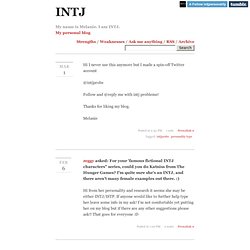
Thanks for liking my blog. Melanie Feb 6 zeggy asked: For your 'famous fictional INTJ characters" series, could you do Katniss from The Hunger Games? Hi from her personality and research it seems she may be either INTJ/ISTP. Hipster INTJ. Ask INTJ. INTJ Central: The Compleat Idiot’s Guide to the INTJ. Table of Contents Introduction Welcome to yet another document about INTJs.
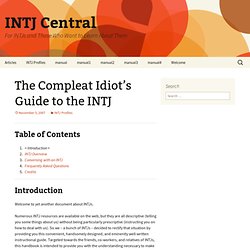
The INTJ Explained. I recently had something of a minor existential breakdown, or experienced the beginning of a big one that I managed to ward off before it got too bad.
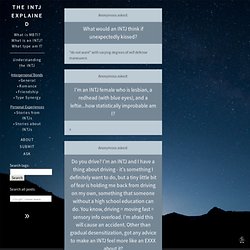
As a result, I became largely absent from tumblr in general for several days, for my own mental health. Then I had a business conference to attend, which took up the better part of a week. This means everything got put on hold, from answering questions to working on selecting a new moderator. I apologize, but I wasn’t going to rush the process and pick somebody while under duress and make them deal with the blog while I was off trying to recover some semblance of control in my life. I thought it would be better to let the blog be quiet for a week or two rather than put myself and the new moderator through unnecessary stress.
INTJ. Keirsey Temperament Sorter. Heading text[edit] The Keirsey Temperament Sorter (KTS) is a self-assessed personality questionnaire designed to help people better understand themselves and others.
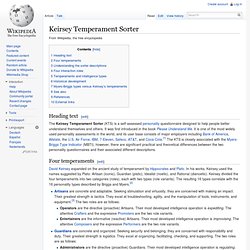
It was first introduced in the book Please Understand Me. It is one of the most widely used personality assessments in the world, and its user base consists of major employers including Bank of America, Allstate, the U.S. Air Force, IBM, 7-Eleven, Safeco, AT&T, and Coca-Cola.[1] The KTS is closely associated with the Myers-Briggs Type Indicator (MBTI); however, there are significant practical and theoretical differences between the two personality questionnaires and their associated different descriptions. Four temperaments[edit] David Keirsey expanded on the ancient study of temperament by Hippocrates and Plato. Myers-Briggs Type Indicator. Model of personality types A chart with descriptions of each Myers–Briggs personality type and the four dichotomies central to the theory The Myers–Briggs Type Indicator (MBTI) is an introspective self-report questionnaire indicating differing psychological preferences in how people perceive the world and make decisions.[1][2][3] The original versions of the MBTI were constructed by two Americans, Katharine Cook Briggs and her daughter Isabel Briggs Myers.[4] The MBTI is based on the conceptual theory proposed by Swiss psychiatrist Carl Jung,[5] who had speculated that people experience the world using four principal psychological functions – sensation, intuition, feeling, and thinking – and that one of these four functions is dominant for a person most of the time.[6] The four categories are Introversion/Extraversion, Sensing/Intuition, Thinking/Feeling, Judging/Perception.
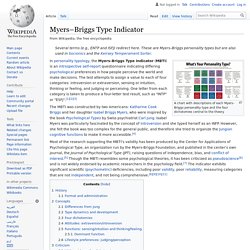
Each person is said to have one preferred quality from each category, producing 16 unique types. History[edit] The mbti types. Do you as an INTJ have any tips for putting up with ESTJs?
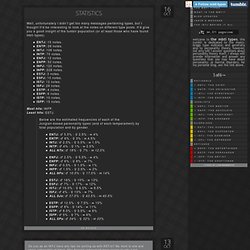
My mom is one and she's unbearable at times. She doesn't understand introversion or why I get annoyed that she takes 5 minutes to talk about something she could sum up in 5 seconds. I don’t really, my neighbour’s an ESTJ and I really… I actually can’t stand him. I mean, he’s a good guy, I realise that, but even when I explain why I don’t care for going out or interacting with a lot of people, he just doesn’t get it.
They’re probably too stuck in their own perception of the world and their own experiences, and they tend to lack the empathy to put themselves into the shoes of someone else. The one thing I usually do when my own mum does that (who’s an INFP) is just tell her to get to the point. The best thing I can suggest to you is to try to explain yourself. Clifton StrengthsFinder. Strengths Finder Strengths List.